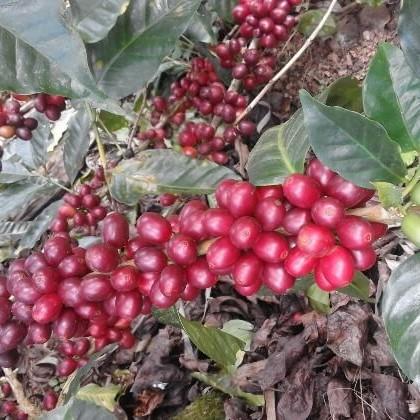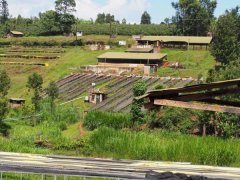History and Development of Bourbon Coffee beans Flavor of Red Bourbon Coffee beans in Tianzhi Manor of Nicaragua
Bourbon is one of the most culturally and genetically important varieties in the world. It is famous for its excellent quality in cups at the highest altitude. The coffee in bourbon is higher, the leaf tip is green, and the size of beans is relatively average. It has the potential of high quality at high altitude.
But it is easily affected by coffee leaf rust and nematode disease and the yield is very low.
French missionaries introduced bourbon from Yemen to the island of Bourbon (now Reunion) in the early 1700s and named it after today. It was not until the mid-19th century that Bourbon left the island. But since the mid-1800s, as missionaries began to establish a foothold in Africa and the Americas, this diversity spread to new parts of the world.
The bourbon variety was introduced to Brazil around 1860 and quickly spread northward to other parts of South and Central America, where it is still grown today. Here, it is mixed with other bourbon-related varieties introduced from India and Ethiopia. Today, many similar bourbon varieties have been found in East Africa, but none of them exactly match the unique bourbon varieties of Latin America.
In Latin America today, bourbon itself has been largely replaced by its offspring (especially Caturra, Catuai and Mundo Novo), although bourbon itself is still grown in El Salvador, Guatemala, Honduras and Peru.
Compared with other coffee trees, bourbon has large, wide leaves, wavy edges and more secondary branches. The berries are quite small and very thick, and can be red, yellow or pink, depending on the subvariety. Red, yellow and pink (sometimes called orange) bourbon is a naturally mutated variety of recessive genes.

Bourbon is valued for its complex acidity and wonderful balance. It usually has sweet caramel quality and crisp acidity, but it can show a very different flavor depending on where it is planted. Salvadoran bourbon tends to show butter, toffee and fresh pastries; people of the Rwandan type tend to be more fruity.
Red bourbon coffee:
Nicaragua Mierisch Finca Las Placeres
Flavor description:
The dry palate has aromas of wine, strawberries and grapes, with intense aromas of wine, blackberries, blackcurrants, mangoes and grapes on the palate, dry red berries and berries in the middle, and Sudan fruit and cocoa in the end.
▪ country. Nicaragua
▪ area of origin. Matagalpa
▪ altitude: 850-1150 m
Processing method: sunshine
Grade: SHG
Variety. Red bourbon
In front of the street, there is also a tanned bourbon "professor" coffee from the Nicaraguan Divine Manor, and from the Divine Manor of New Segovia. Everyone is welcome to taste it.

Yellow bourbon
It is believed to be the "natural" mutation of red bourbon first discovered in Brazil in the 1930s.
On the front street
Pink bourbon
Another "natural" mutation of red bourbon was first discovered and developed in El Salvador. The cherries of this plant are usually pink / pink, so they are sometimes called "pink" bourbon.
Important Notice :
前街咖啡 FrontStreet Coffee has moved to new addredd:
FrontStreet Coffee Address: 315,Donghua East Road,GuangZhou
Tel:020 38364473
- Prev

Brief introduction of Panamanian 90 + Rosa Manor du Jianning Champion 90 + Rosa Special treated Coffee Bean Flavor
After watching du Jianning's cooking video again yesterday, I couldn't help but write an article about Panama 90 + Rose Summer to consolidate my knowledge. Qianjie is coming to explore with you today. Today, we will focus on 90 + Manor and 90 + Rose Summer Manor. In the 1990s, the manor is the quintessence of the 90 + brand sports world. It is located on the west slope of the Baru volcano, and these places are the first in the world.
- Next

Brief introduction of Kenya processing Plant Gakuyuini and Coffee Bean processing Thirikwa Farmers' Cooperation
Kenya's coffee industry is famous for its systematic cooperation system of production, processing and marketing. About 70% of Kenyan coffee is produced by small-scale growers. Qianjie pays special attention to the Gakuyuini processing station with you today. Coffee grade: AB full water washing farm / cooperative / station: Gakuyuini treatment station variety: SL28, SL34 processing:
Related
- Detailed explanation of Jadeite planting Land in Panamanian Jadeite Manor introduction to the grading system of Jadeite competitive bidding, Red bid, Green bid and Rose Summer
- Story of Coffee planting in Brenka region of Costa Rica Stonehenge Manor anaerobic heavy honey treatment of flavor mouth
- What's on the barrel of Blue Mountain Coffee beans?
- Can American coffee also pull flowers? How to use hot American style to pull out a good-looking pattern?
- Can you make a cold extract with coffee beans? What is the right proportion for cold-extracted coffee formula?
- Indonesian PWN Gold Mandrine Coffee Origin Features Flavor How to Chong? Mandolin coffee is American.
- A brief introduction to the flavor characteristics of Brazilian yellow bourbon coffee beans
- What is the effect of different water quality on the flavor of cold-extracted coffee? What kind of water is best for brewing coffee?
- Why do you think of Rose Summer whenever you mention Panamanian coffee?
- Introduction to the characteristics of authentic blue mountain coffee bean producing areas? What is the CIB Coffee Authority in Jamaica?

